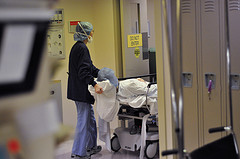Cisco fills Mac Uni's Nortel gap


Integrator 3D Networks has won a $3 million deal to build a communications and radio-frequency identification (RFID) system for the new Macquarie University Hospital, changing partners from Nortel to Cisco after the university voiced concerns about Nortel's bankruptcy protection filing last year.
The company will supply an IP network using Cisco and AeroScout technology to connect Macquarie University's new $180 million 185-bed hospital in North Ryde, linking 15 theatres, the School of Advanced Medicine's research centre and multiple clinics. The network will allow hospital staff to use voice services and access information away from their desks. For use on the network, 800 Cisco Unified IP Phones will be rolled out.
The system has been designed so hospital staff can also track equipment like gurneys and intravenous machines tagged using Radio Frequency Identification. Similarly, Wi-Fi tags will be attached to a range of medical items to automate inventory management and receive real-time inventory counts. Over 1000 tags will be attached to medical equipment. The system will also have the capability to track patients, but this will not be turned on yet, according to 3D Networks CEO Rod Taylor.
Networking giant Cisco will be providing the Wi-Fi network whilst Aeroscout will be providing tracking and tagging technology.
The deal in its entirety was worth around $3 million, according to Taylor, with over $2 million falling into 3D Network's coffers. Originally, Nortel had been the vendor that 3D Networks was partnering for the deal, but that had changed after Nortel experienced financial concerns.
"The original design was certainly built around the Nortel system," Taylor told ZDNet.com.au. The contract had been awarded, he said, but during due diligence the university raised concerns about Nortel's Chapter 11 bankruptcy protection filing (which didn't include Australia and New Zealand), asking 3D Networks to bring in an alternate proposal for the deal.
As 3D Networks was vendor agnostic, it did so, and the university chose the proposal using Cisco technology. In the end, according to Taylor, Cisco's system had fitted well with the university's needs. "It's an example of why you'd go with a multi-vendor," he said.
"Our focus on health care is really the combination of technologies that fuse voice and data solutions and provide custom applications over the top of [vendors'] infrastructure," he said.
